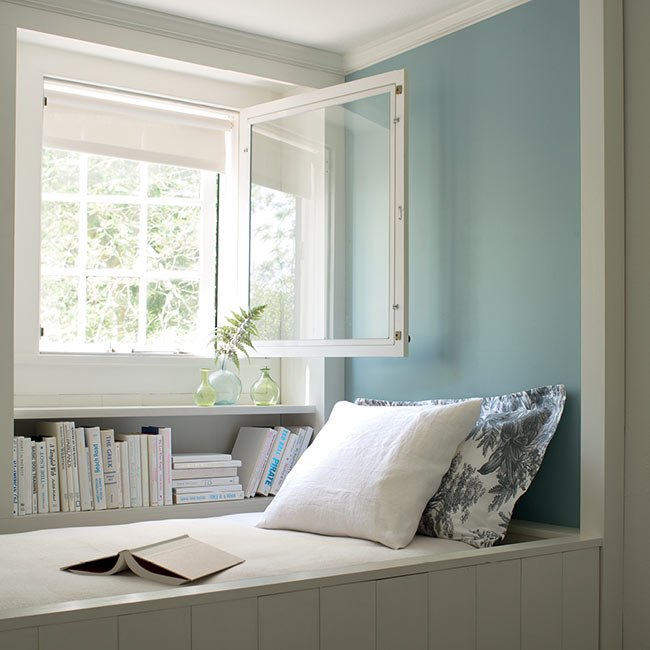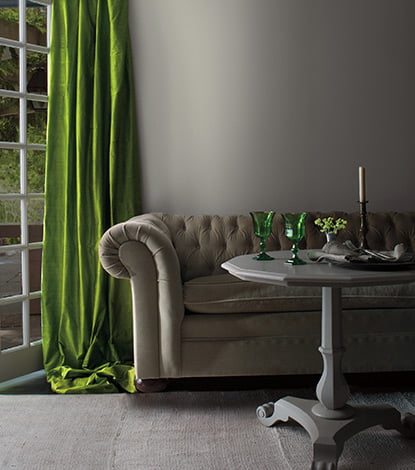If the allure of onyx, ruby, emerald and other bold, saturated hues has caught your eye, this palette makes it easier to dive in.
Explore the design impact–both big and small–darker shades can have on your home.
The Color Palette
This palette of 23 colors was hand-selected to interact seamlessly. Mix, match and put the power of the Benjamin Moore Color & Design team to work for you.
The Multi-Faceted Nature of Deeps
Deep colors bring a sense of drama to any room. But what about the softer side?
When it comes to darker colors, light is a powerful protagonist. Deeply-hued rooms with skylights, French doors, or any level of ambient light help to enhance deep colors, creating an intriguing interplay of light and dark.
Take the gray undertones of Shadow 2117-30–our Color of the Year 2017–for example: The purple hue responds more like a neutral under the influence of natural light. As the day gets darker, Shadow deepens, adding more intensity to the room. Wet Concrete 2114-40 has a similar effect.
Test the Waters
Saturated, rich colors are an easy choice for those who have a proclivity for them in the first place. If you are new to deeps, you may want to start small:
Embolden a project– Paint the inside of your book shelves or a small powder room with deep hues–they’re perfect projects for testing out stronger shades.
Use a bold stroke– Add some punch to a flight of wooden stairs with a banister in Night Shade 2116-10 or risers in Salamander 2050-10. Or test the waters on a smaller-scale accent wall as seen here.
Look inside– Are deep colors in your wardrobe? In your jewelry box? Pay attention to your personal color palette.
Elaborate
If you choose deep colors on the majority of a room’s walls, fabrics like velvet or brocade provide both balance and dimension. Consider fabrics in lighter shades for an appealing contrast against more intense colors.
Metallics also work wonders against deeps, bringing reflection and energy into a deeply-hued room. Bronze picture frames, sterling silver candlesticks or a polished chrome lamp add iridescence and reflection.
Pair with Your Choice of Product
Colors mentioned here are available for use in a range of Benjamin Moore paints. Explore the product that’s right for you in The Right Paint or Stain for your Project section.
The Color Palette
This palette of 23 colors was hand-selected to interact seamlessly. Mix, match and put the power of the Benjamin Moore Color & Design team to work for you.
Pink Bliss
2093-70
AF-680
Etruscan
AF-355
Porcelain
2113-60
Sea Life
2118-40
Knoxville Gray
HC-160
Dinner Party
AF-300
Night Shade
2116-10
Chalk White
2126-70
Cloud Cover
OC-25
Stormy Monday
2112-50
Wet Concrete
2114-40
Shadow
2117-30
Guacamole
2144-10
Salamander
2050-10
Ebony King
2132-20
The Multi-Faceted Nature of Deeps
Deep colors bring a sense of drama to any room. But what about the softer side?
When it comes to darker colors, light is a powerful protagonist. Deeply-hued rooms with skylights, French doors, or any level of ambient light help to enhance deep colors, creating an intriguing interplay of light and dark.
Take the gray undertones of Shadow 2117-30–our Color of the Year 2017–for example: The purple hue responds more like a neutral under the influence of natural light. As the day gets darker, Shadow deepens, adding more intensity to the room. Wet Concrete 2114-40 has a similar effect.
Test the Waters
Saturated, rich colors are an easy choice for those who have a proclivity for them in the first place. If you are new to deeps, you may want to start small:
Embolden a project– Paint the inside of your book shelves or a small powder room with deep hues–they’re perfect projects for testing out stronger shades.
Use a bold stroke– Add some punch to a flight of wooden stairs with a banister in Night Shade 2116-10 or risers in Salamander 2050-10. Or test the waters on a smaller-scale accent wall as seen here.
Look inside– Are deep colors in your wardrobe? In your jewelry box? Pay attention to your personal color palette.
Elaborate
If you choose deep colors on the majority of a room’s walls, fabrics like velvet or brocade provide both balance and dimension. Consider fabrics in lighter shades for an appealing contrast against more intense colors.
Metallics also work wonders against deeps, bringing reflection and energy into a deeply-hued room. Bronze picture frames, sterling silver candlesticks or a polished chrome lamp add iridescence and reflection.
Pair with Your Choice of Product
Colors mentioned here are available for use in a range of Benjamin Moore paints. Explore the product that’s right for you in The Right Paint or Stain for your Project section.
Questions?
we're here for you.

Drop us a line today!
Frequently Asked Questions
When touching up a hole repair, why do I notice a difference, why is the color different?
Paint ages and loses sheen over time, so even within 3 months of painting, the wall is now less shiny than the touch up, meaning it will stand out more. In time the touch up will dull down and blend in a little, but the touchup must be applied lightly in order to keep the wall looking as close to uniform as possible.
Should I do two coats?
You should always do two coats for the following reasons:
-Uniform color - if you only do one coat there is no guarantee that the color will be uniform if the previous color is showing through due to improper film build.
-When doing a color change you should definitely not rely on one coat, depending on what you’re changing to, 2 coats is usually enough.
Do I need to prime?
Priming is necessary when you have new drywall/drywall mud to seal it so that it doesn’t absorb more paint than is needed. Also if doing a color change from dark to light 1 coat of primer might be recommended in order to achieve the desired color.
Why do I need to wait for the paint to dry?
The re-coat window is necessary to ensure that your 2nd coat doesn’t re-wet the first coat. Applying paint too early can just re-activate the previously applied coat of paint, meaning that you don’t get a proper two coat film build, and so it doesn’t cover as two proper coats.
How long do I wait to be able to wash my walls
Most paints require 28 days to full harden and cure, giving you maximum durability for the product. only ever wash your walls with warm soapy water, avoiding bleach or ammonia based cleaning products.


























